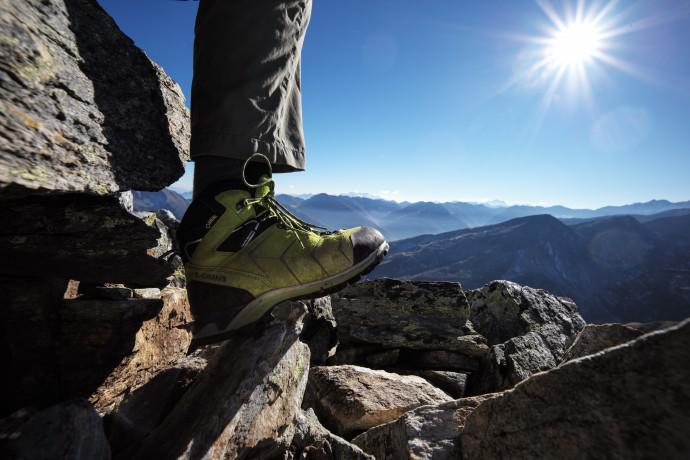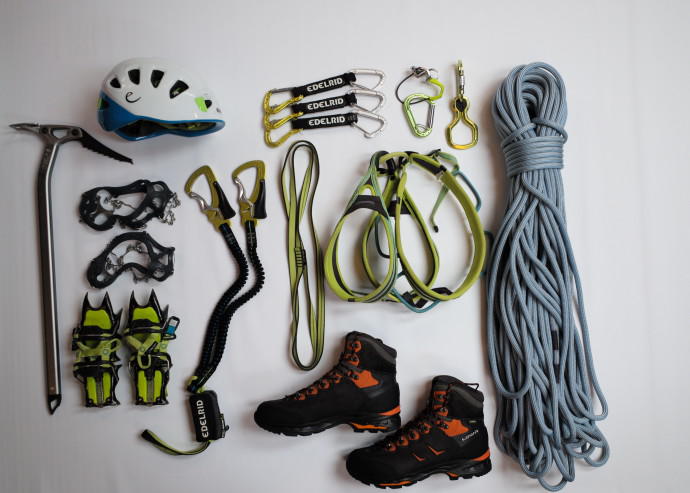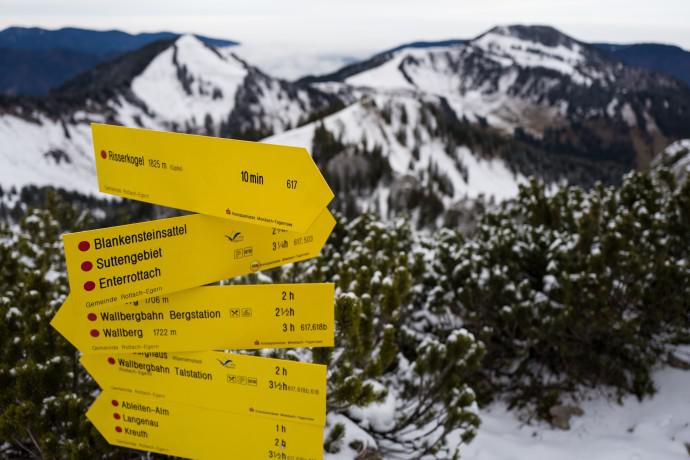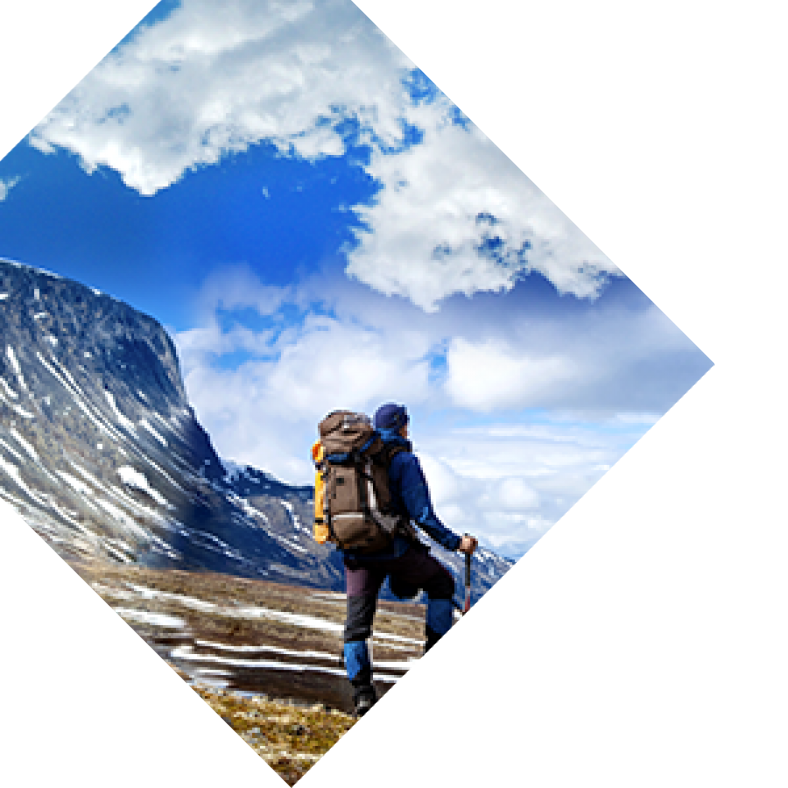The world up in the mountains is breathtakingly beautiful, with wildflowers in bloom on high meadows, idyllic tracks, and utterly gorgeous views. The fascination too comes from the rugged side of the mountains with its vertical rock faces, wild glaciers and innumerable unpredictable conditions from weather and terrain.
That’s why it pays to get familiar with the necessary respect and necessary caution required in the high mountains – in any cases, alpinists must, but also hikers and the increasing number of trail runners who often head out with just lightweight gear should too. Christof Schellhammer isn’t just a mountain guide and co-owner of the mountain and ski school Vivalpin. He is also the race director of the GORE-TEX Transalpine Run. In this capacity, he is also responsible for the safety of the athletes.
Here are his top tips for mountain enthusiasts and those who want to become outdoor athletes:
Trip planning
Before every intended mountain adventure, one should allow enough time for planning. This doesn’t just apply for more challenging trips but all trips. How long are you going to be out? How many vertical metres will you take on? What is the fitness level of your companions and how much alpine experience do they have? What kind of conditions and weather are expected? Does the route have challenging passages, for example a simple via ferrata or even a section that will demand specialised alpine gear such as crampons or a climbing harness? What kinds of provisions need to be packed? Are there rest stops such as managed huts that offer food and drink or mountain lodges? All of these questions must be considered when doing responsible tour planning.
The most important equipment …

…is your footwear. That’s because it is where you and the terrain (be it, trails, rock, ice, etc.) make contact. The choice in footwear for the mountains is huge: trekking boots, hiking boots, outdoor boots, or multifunctional shoes. The correct choice of course depends on the intended use. A professional salesperson in a speciality sport shop will gladly help you sort out what type of footwear will be best for you. When searching for the perfect product, you should give yourself some time. Head into a shop after you have spent a little time walking around so your circulation is fully pumping, including to your feet. Wear your favourite shoes or boots a bit longer and take a stroll around the shop to see if they remain comfortable. Once you have found your ideal footwear, it is advisable to break them in on a short outing. Then you shouldn’t have any problems on longer undertakings. When it comes to trail running shoes, you should pay particular attention to technical features. The sole in particular is very important. It should offer maximum grip on many surfaces, even when the surface is wet or damp. A breathable, waterproof GORE-TEX membrane is recommended for the upper when you plan on activities in the high mountains.
Weather
Every mountain athlete recognises that weather in mountainous regions has a mind of its own. And figuring it out is not very predictable. In general, one can say that changes in the weather happen much more quickly in the mountains than in the flatlands – and often that carries with it bigger consequences. One needs to just think about how you’d be at the mercy of a strong thunderstorm if you didn’t have protection. Thus, it is part of planning every tour to check into the weather report and also to observe beforehand how the weather is developing. If the weather isn’t optimal, one should plan on a simpler, more weather-appropriate option. If that isn’t possible, one should simply not head out and postpone the trip.
Weather reports
Not every weather report is the same. Generally speaking, we like to caution people against the typical weather apps. These are normally based on computer modelling that doesn’t take into account regional specifications. Thus, they are totally inappropriate when planning trips in the high mountains. Worth recommending are special mountain weather forecasts such as those provided in Austria and South Tyrol by ZAMG Innsbruck (Central Institution for Meteorology and Geodynamics) or those in Switzerland from Meteoschweiz by the Federal Office of Meteorology and Climatology . In addition, having a bit of basic knowledge and an understanding of typical weather patterns in the mountains can’t hurt.
 Must-have gear
Must-have gear
Certain things should be standard and always packed along on any trip. That includes sufficient liquids and nutrition, a mobile phone for emergencies, a map, and of course always a first-aid kit, with a GPS being optional. In the high mountains, one must naturally also have weather protection, cap, gloves and perhaps a change of shirts stashed in the pack. Trekking poles offer additional aid and support in many situations, not only on the descent.
Smart educational courses for budding alpinists
For anyone who wants to explore the world of the high mountains on normal tracks and beyond, a course taught by professionals is also recommended.
Tour difficulty ratings
In guidebooks and on the Internet, many hiking routes are described using the generally accepted difficulty classifications – yellow, blue, red and black. Yellow is the easiest and shouldn’t offer any issues; blue can have steep grades but there is no danger of falls and is technically easy; red hiking routes could include passages where there is a danger of falling, but still mostly follow marked routes. For hiking tracks marked black, being surefooted is absolutely a necessity since there is a danger of falling on many passages and you may in part secure yourself with ropes or chains along the way. Via ferratas, climbing expeditions, or high-alpine treks are not included in these basic classifications; there are separate difficulty grades for these.
Time considerations when planning

How long do I need for the trip? When will I reach the summit? When planning, there are various ways to calculate the time demanded. The most important factor here is a realistic self-assessment. For your first adventure, you should pay heed to the time needed as stated in the literature or on trail markers. Depending on your fitness level, you’ll either need this amount of time, exceed it, or beat it. For future tours, you can then use your experience to adapt the “official” time to you. This tactic is not only appropriate for beginners. Even experienced alpinists or trail runners will need to orient themselves based on their own experiences. When you know how many vertical metres and kilometres you can complete per hour, then you will be able to more exactly plan time needed for each tour.
Christof Schellhammer, race director of the GORE-TEX Transalpine Run
 …is your footwear. That’s because it is where you and the terrain (be it, trails, rock, ice, etc.) make contact. The choice in footwear for the mountains is huge: trekking boots, hiking boots, outdoor boots, or multifunctional shoes. The correct choice of course depends on the intended use. A professional salesperson in a speciality sport shop will gladly help you sort out what type of footwear will be best for you. When searching for the perfect product, you should give yourself some time. Head into a shop after you have spent a little time walking around so your circulation is fully pumping, including to your feet. Wear your favourite shoes or boots a bit longer and take a stroll around the shop to see if they remain comfortable. Once you have found your ideal footwear, it is advisable to break them in on a short outing. Then you shouldn’t have any problems on longer undertakings. When it comes to trail running shoes, you should pay particular attention to technical features. The sole in particular is very important. It should offer maximum grip on many surfaces, even when the surface is wet or damp. A breathable, waterproof GORE-TEX membrane is recommended for the upper when you plan on activities in the high mountains.
…is your footwear. That’s because it is where you and the terrain (be it, trails, rock, ice, etc.) make contact. The choice in footwear for the mountains is huge: trekking boots, hiking boots, outdoor boots, or multifunctional shoes. The correct choice of course depends on the intended use. A professional salesperson in a speciality sport shop will gladly help you sort out what type of footwear will be best for you. When searching for the perfect product, you should give yourself some time. Head into a shop after you have spent a little time walking around so your circulation is fully pumping, including to your feet. Wear your favourite shoes or boots a bit longer and take a stroll around the shop to see if they remain comfortable. Once you have found your ideal footwear, it is advisable to break them in on a short outing. Then you shouldn’t have any problems on longer undertakings. When it comes to trail running shoes, you should pay particular attention to technical features. The sole in particular is very important. It should offer maximum grip on many surfaces, even when the surface is wet or damp. A breathable, waterproof GORE-TEX membrane is recommended for the upper when you plan on activities in the high mountains.
 Must-have gear
Must-have gear How long do I need for the trip? When will I reach the summit? When planning, there are various ways to calculate the time demanded. The most important factor here is a realistic self-assessment. For your first adventure, you should pay heed to the time needed as stated in the literature or on trail markers. Depending on your fitness level, you’ll either need this amount of time, exceed it, or beat it. For future tours, you can then use your experience to adapt the “official” time to you. This tactic is not only appropriate for beginners. Even experienced alpinists or trail runners will need to orient themselves based on their own experiences. When you know how many vertical metres and kilometres you can complete per hour, then you will be able to more exactly plan time needed for each tour.
Christof Schellhammer, race director of the GORE-TEX Transalpine Run
How long do I need for the trip? When will I reach the summit? When planning, there are various ways to calculate the time demanded. The most important factor here is a realistic self-assessment. For your first adventure, you should pay heed to the time needed as stated in the literature or on trail markers. Depending on your fitness level, you’ll either need this amount of time, exceed it, or beat it. For future tours, you can then use your experience to adapt the “official” time to you. This tactic is not only appropriate for beginners. Even experienced alpinists or trail runners will need to orient themselves based on their own experiences. When you know how many vertical metres and kilometres you can complete per hour, then you will be able to more exactly plan time needed for each tour.
Christof Schellhammer, race director of the GORE-TEX Transalpine Run

